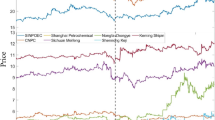Abstract
This research examines the linkages among three Greater China Economic Area (GCEA) stock markets, including Mainland China, Hong Kong, and Taiwan, and two developed markets, Japan and the United States. We find that: (1) a random walk model is outpredicted by an autoregressive GARCH model and an ARIMA model in all three GCEA markets; (2) the three GCEA markets are not cointegrated with either U.S. or Japan but there exists weak nonlinear relationships between these markets; and (3) result from the innovation accounting analysis reveals that the U.S. market has larger influence on the GCEA markets than the Japanese market. Additionally, Hong Kong is the most influential among the three GCEA markets.
Similar content being viewed by others
References
Allen, M., and G. MacDonald, “The Long-Run Gains from International Equity Diversification: Australian Evidence from Cointegration Tests.” Applied Financial Economics 5, 33–42 (1995).
Aggarwal, R. C. Inclan and R. Leal, “Volatility in Emerging Stock Markets.” Journal of Financial and Quantitative Analysis 34, 33–55 (1999).
Aggarwal, R, M. Mougoue, “Cointegration Among Asian Currencies: Evidence of the Increasing Influence of the Japanese Yen.” Japan and the World Economy 8, 291–308 (1996).
Aggarwal, R, A. Montanes, and M. Ponz, “Evidence of Long-Run Purchasing Power Parity: Analysis of Real Asian Exchange Rates in Terms of the Japanese Yen.” Japan and the World Economy 12, 351–361 (2000).
Azman-Saini, W., M. Azali, M. S. Habibullah, and K. G. Matthews, “Financial Integration and the ASEAN-5 Equity Markets.” Applied Economics 34, 2283–2288 (2002).
Campbell, J. Y., and Y. Hamao, “Predictable Stock Returns in the United States and Japan: A Study of Long-Term Capital Market Integration.” Journal of Finance 47, 43–70 (1992).
Chan, K. C., B. Gup, and M. Pan, “An Empirical Analysis of Stock Prices in Major Asian Markets and the United States.” Financial Review 27, 289–307 (1992).
Cheung, Y., and L. K. Ng, “A Causality-in-Variance Test and Its Application to Financial Market Prices.” Journal of Econometrics 72, 33–48 (1996).
Chowdhury, A. R., “Stock Market Interdependencies: Evidence from the Asian NIEs.” Journal of Macroeconomics 16, 629–651 (1994).
Corhay, A., A. T. Rad, and J. Urbain, “Long Run Behavior of Pacific-Basin Stock Prices.” Applied Financial Economics 5, 11–18 (1995).
Darrat, A., and M. Zhong, “On Testing the Random-Walk Hypothesis: A Model Comparison Approach.” Financial Review 35, 105–124 (2000).
Darrat, A., and M. Zhong, “Permanent and Transitory Driving Forces in the Asian-Pacific Stock Markets.” Financial Review 37, 35–52 (2002).
Engle, R. F., and C. W. J. Granger, “Co-integration and Error Correction: Representation, Estimation, and Testing.” Econometrica 55, 251–276 (1987).
Fama, E. F., and K. R. French, 1989. “Business Conditions and Expected Returns on Stocks and Bonds.” Journal of Financial Economics 25, 23–49 (1989).
Geweke, J., “Measure of Nonlinear Dependence and Feedback Between Multiple Time Series.” Journal of the American Statistical Association 77, 304–313 (1982).
Ghosh, A., R. Saidi, and K. H. Johnson, “Who Moves the Asia-Pacific Stock Markets - Japan or US? Empirical Evidence Based on the Theory of Cointegration.” Financial Review 34, 159–170 (1999).
Goetzmann, W. N., and P. Jorion, “Re-Emerging Markets.” Journal of Financial and Quantitative Analysis 34, 1–33 (1999).
Granger, C. W. J., “Development in the Study of Cointegrated Economic Variables.” Oxford Bulletin of Economics and Statistics 48, 213–228 (1986).
Hung, B. and Y. L. Cheung, “Interdependence of Asian Emerging Equity Markets.” Journal of Business Finance & Accounting 22, 281–288 (1995).
International Finance Corporation. 2000. Emerging Markets Fact Book. Washington D.C.: IFC.
Johansen, S., “Statistical Analysis of Cointegrating Vectors.” Journal of Economic Dynamics and Control 12, 231–254 (1988).
Johansen, S., “Estimation and Hypothesis Testing of Cointegrating Vectors in Gaussian Vector Autoregressive Models.” Econometrica 59, 1551–1580 (1991).
Johansen, S. and K. Juselius, “Maximum Likelihood Estimation and Inference on Cointegration with Application to the Demand for Money.” Oxford Bulletin of Economics and Economics and Statistics 52, 169–210 (1990).
Johnson, R. and L. Soenen, “Asian Economic Integration and Stock Market Comovement.” Journal of Financial Research 25, 141–157 (2002).
Kwok, R. H., “Market Integration in the Four Newly Industrialized Economies of Asia.” in T. Bos and T. A. Fetherston, ed., Advances in Pacific Basin Financial Markets, Jai Press, Connecticut, 199–209, 1995.
Marcus, A. J., “An Equilibrium Theory of Excess Volatility and Mean Reversion in Stock Market Prices.” National Bureau of Economic Research Working Paper no. 3106, 1989.
Markowitz, H., “Portfolio Selection.” Journal of Finance 7, 77–91 (1952).
Masih, A. M. and R. Masih, “A Comparative Analysis of the Propagation of Stock Market Fluctuations on Alternative Models of Dynamic Causal Linkage.” Applied Financial Economics 7, 59–74 (1997).
Okunev, J., and J. Wilson, “Using Nonlinear Tests to Examine Integration between Real Estate and Stock Markets.” Real Estate Economics 25, 487–503 (1997).
Phillips, P., and P. Perron, “Testing for a Unit Root in Time Series Regression.” Biometrika 75, 335–346 (1988).
Reimers, H. E., “Comparisons of Tests for Multivariate Cointegration.” Statistical Papers 33, 335–359.
Sharma, S. and P. Wongbangpo, “Long-Term Trends and Cycles in ASEAN Stock Markets.” Review of Financial Economics 11, 299–315 (2002).
Siegel,. J., Stocks for the Long Run. New York: McGraw-Hill, 1998.
Taylor, M. and I. Tonks, “The Internationalization of Stock Markets and the Abolition of U.K. Exchange Control.” Review of Economics and Statistics 71, 332–336 (1989).
Wheatley, S., “Some Tests of International Equity Market Integration.” Journal of Financial Economics 21, 177–212 (1988).
Author information
Authors and Affiliations
Corresponding author
Additional information
JEL Classification: G10, G14, G15
Opinions and results presented in this paper are those of the authors and are not intended to represent the views, policies, or interests of Fannie Mae. This paper is not the result of Fannie Mae related research and does not use or cite Fannie Mae data sources.
Rights and permissions
About this article
Cite this article
Cheng, H., Glascock, J.L. Dynamic Linkages Between the Greater China Economic Area Stock Markets—Mainland China, Hong Kong, and Taiwan. Rev Quant Finan Acc 24, 343–357 (2005). https://doi.org/10.1007/s11156-005-7017-7
Issue Date:
DOI: https://doi.org/10.1007/s11156-005-7017-7




